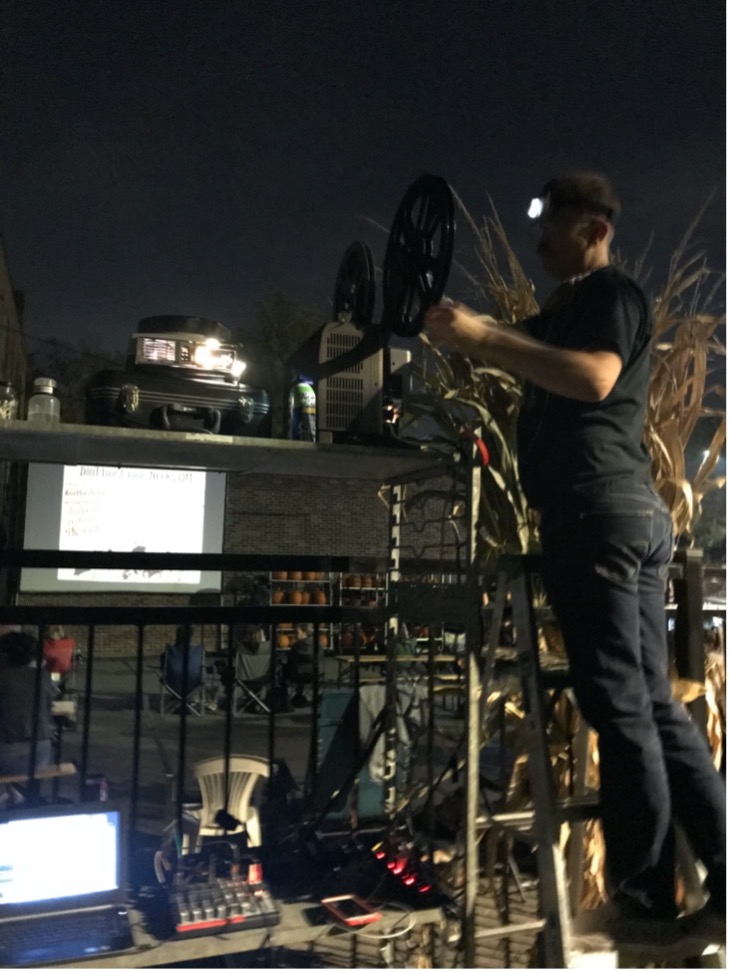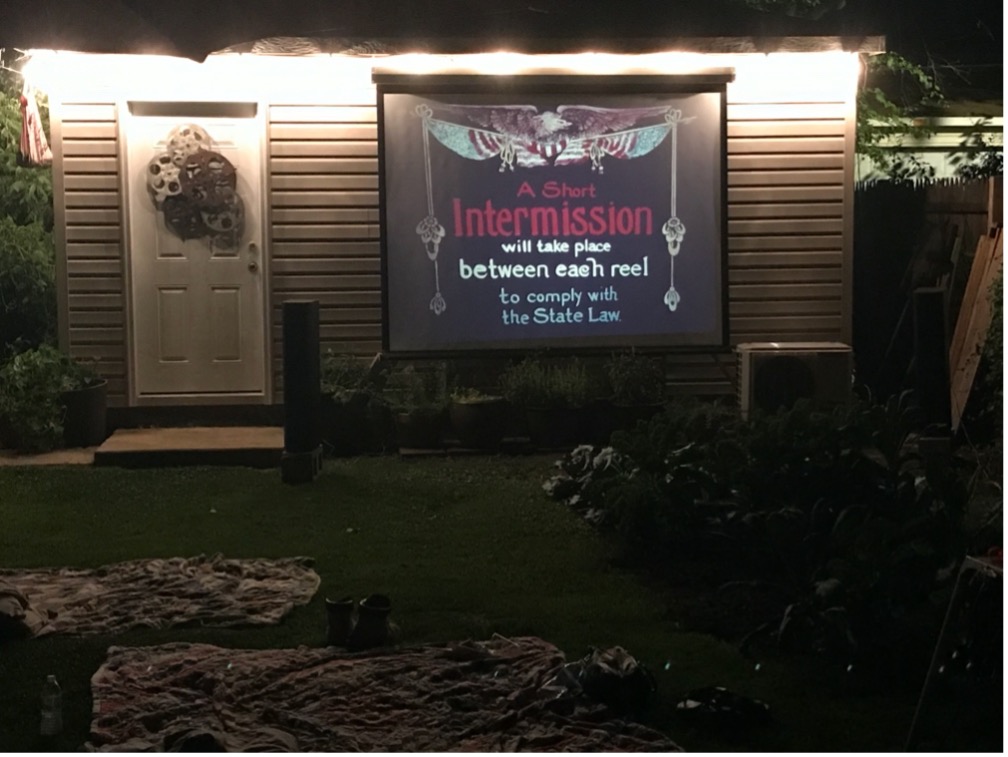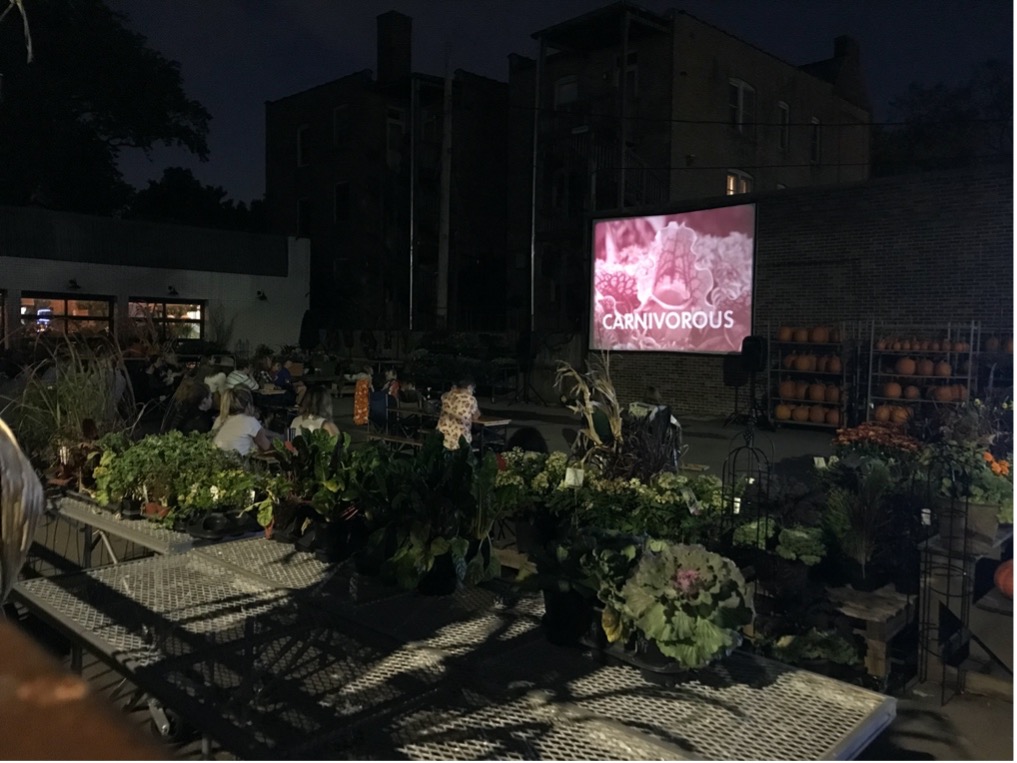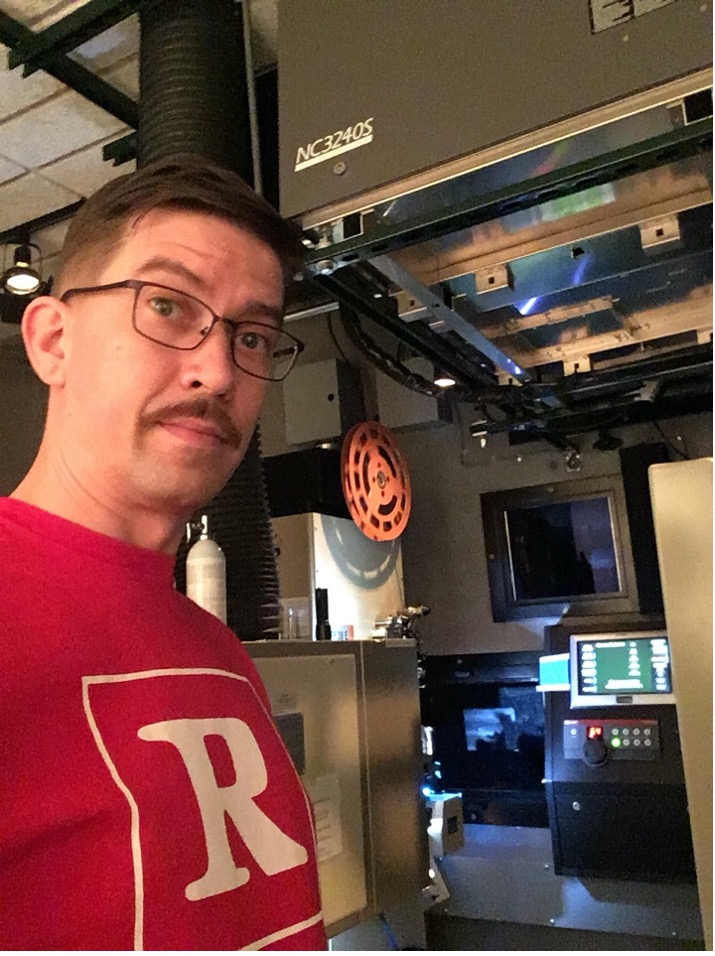Ben Ruder, Manager, Film and Technical Operations at the University of Chicago Film Studies Center (FSC), has had a busy lockdown year. Besides the immense technical support and digitization efforts he provides for Cinema and Media Studies department remote screenings, he also has been hard at work on his own project, Enjoy the Film. As Ruder described it on his website, “Movie trailers are seen before every screening and disposed of after their advertisement value has diminished. This project’s goal is to preserve these materials that have ended up in the hands of collectors, ensuring they can be run through a projector again and providing a resource to the community of film history researchers and to venues in need of films.” Enjoy the Film is a project that spans several decades and places, and that has screened many different types of films, from film trailers to educational films. I had a virtual conversation with Ruder to find out how Enjoy the Film started and how it’s changed over time, as well as his work at the FSC and the further support he can offer to instructors and students.
When Ruder was 17, he began working in a movie theater at the local mall, after jobs as a baseball umpire and at McDonalds. “I started as an usher at the AMC Crestwood 10, tearing tickets and cleaning the theater and lobby,” he recalls. “Being the point person for the audience empowered me to talk to complete strangers, which I couldn’t imagine previously because of my severe social anxiety of those type of interactions.” Before long, the management promoted him to sell concessions, where he made friends with the 20-year-old college students who worked in the projection booth. “On Thursday nights they’d get films in and hold after-close staff screening of movies like Dumb and Dumber and Fargo. It was one of the first times I’d seen that kind of non-slick action comedy in a theater. I was watching art onscreen.”
Ruder was soon promoted to staff supervisor, then head of the booth, and then manager—at which point he went to another theater, since this was the big multiplex boom of the ‘90s. He also went to university but left because he knew he wanted to do TV production. “I did that for quite a long time,” he says. “In some ways it’s what I still do. The understanding of film or video production is ingrained in a lot of us now: knowing how to use software and lighting for a webcam or shooting on a cellphone is part of everyone’s life after the democratization of these products. Back then, I used a broadcast camera that weighed 30 pounds with a battery pack, so everything else feels like cheating to me.” Ruder went to a trade school called Full Sail University in Orlando, FL for film and video production. He then went to Atlanta to work for independent production companies. “I ended up doing graphics for sports and working for the Fox regional cable networks. Turner would hire me for things like the NBA All-Star Game and live musical concerts. I worked the camera onstage for Justin Timberlake in 2003. I traveled nearly every week, crisscrossing the Midwest and South. Those are experiences you only have in your twenties because you can do anything when you’re young.”
Ruder’s early interest in movies and film came from both his movie theater and media production experience. As he learned the more technical aspects of video production, he adopted the mindset that the best film experiences have the best projection quality. “Why would you eat a McDonalds burger when there’s a better one or you can make it at home? I would never go to a theater to watch a revival of a movie that’s being played on video—for example, to a theater to watch a DCP of Wayne’s World. But if you have a film print, I will buy my ticket right now. That’s a time travel event for me, because I saw a film print of it when it first released and I have this visceral memory of that experience. That film print has been seen by thousands of people, because it goes back in the can and is screened again. It has a material connection to people, whether we want to believe it or not. A video file, by contrast, is electricity that dissipates and moves throughout our electrical network.” Ruder has spent many hours alone in projection booths thinking about how to describe the goal of Enjoy the Film to people. He reflects, “Many ‘death of cinema’ articles make a comparison to the vinyl revival: while people can have those physical objects in their homes, they can’t have the same relationship with a film print, since they don’t handle prints in the booth. They don’t have a technical understanding of what they are seeing or even know it’s film unless there’s a physical defect like dirt, scratches, or splices. The vinyl comparison doesn’t work, so we need to make a new one: that film is a piece of art that is exhibited over and over.”

Enjoy the Film began in 2007, when Ruder’s friends purchased the Plaza Theatre, a 1939 community movie theater in a strip shopping complex in Atlanta. Ruder started working part time there because he was getting burned out on his video production work for TV and marketing companies. “We established a culture around a movie theater with old and sub-run movies, Rocky Horror and other cult programming series,” he says. “We created a community of people who went to that theater for certain events, which is only way those theaters can survive. Instead of people picking whichever movie has seats available or fits their mood, we had people going to the Silver Scream Spook Show because they do a live stage event and then show Bride of the Monster. It was always more than a movie.”
When his friends had to sell the theater in 2012, Ruder wanted to keep working in a job that combined the showmanship of screening film events with the marketing techniques he had learned from working directly with marketers for products and events. Ruder started working with a company that did equipment sales, technical support, and live events for the motion picture industry. Ruder worked their last big film event, “Screen on the Green,” where he helped set up a 23×46-foot screen on the National Mall in Washington DC. Thousands of people came to this quasi-drive-in theater—except, they walked in and sat down. While doing this, Ruder also hosted his friends’ Splatter Cinema horror film series at the office screening room. It was an odd combination. “The only film you’d see in Atlanta for two years was weekly public screenings at Emory University,” where Ruder also projected. “Meanwhile, I worked part time at a company that takes out film equipment to install digital—it was heartbreaking to see film decay in front of my eyes and to benefit from it while I earned money from this part-time job. So, I did anything I could to keep working with film.”
In 2015, Ruder applied for his current job and moved to Chicago in a hurry. “I had a screening for Enjoy the Film at the beginning of September; I interviewed at the FSC the next week, moved the week after that, and school started the week after. The whole dynamic of my life changed. I was able to do something I was interested in full-time and learn from and talk with a community of people also interested in film.” Initially, a large part of his job was to figure out the computer-integrated and -controlled booths and the film projectors he’d never used before, which are very high-end German made projectors primarily found in universities and museums. But before long, he became passionate about teaching the fundamentals of video and film, including their operation and different applications in UChicago screening rooms. Along with the FSC’s Assistant Director, Julia Gibbs, he feels strongly about teaching the performance aspect of projecting films. “Projectionists are invisible, and showmanship is important,” he explains. “There aren’t any intended breaks, no leader is visible on the screen, and the lights go off before the first image appears. These are all basic things you have to be taught and you don’t think about them while watching a film. A technically competent performance is important because we are providing the atmosphere and performing on behalf of the filmmakers. The audience should be absorbed in the experience, and not the technical flaws of the operator or equipment. They are transported to another dream-like world for the next 90 minutes.” Ruder relishes the fact that UChicago is a unique institution in that it runs as much film as it does. Pre-pandemic, there were 7-10 performances on film a week at the FSC. “It’s a lot,” Ruder laughs, “but I like it.”
Currently, Ruder is creating FSC multimedia technical guides to teach non-projectionists how film handling and projection happen, including the basic operations of a film projector. This project began as a manual for training student employees, which also covers how the FSC works and its role in department and public programming. In addition to a paper projection manual, he has been shooting videos to supplement written descriptions and images that show projection components. “It’s a living training manual for student projectionists who maybe haven’t run 16mm in a while. These videos will support that: they can watch how to thread 16mm.” Ruder plans to make portions of these videos available for instructors and graduate students. “If they have interests in understanding the process, or if they’re teaching ‘Introduction to Film’ or ‘Film and the Moving Image,’ these videos show what’s happening in the projection booth.”
Working at the FSC has prompted Ruder to think more about public access to film. “The booth door was always closed—it says, ‘no admittance, projection booth.’ No one gets to go in except for employees. Now, I can literally open up that door and walk a group of people in. I not only give them a tour like it’s part of a building tour, but I can spend hours with someone and explain how film works in this booth.” Ruder also had an a-ha moment when one of his friends, a programmer at Turner Classic Movies, said she’d never been in a film booth before. Ruder knows that it can be difficult to access booths, but he wants to be able to offer that access. “If you’re a film scholar or a working programmer, you should visit a booth, and if you have more than a passing interest you should take advantage when you can.” he says. “A great deal of what I’ve learned, if not everything, has been through experience and apprenticeship.”

The COVID-19 lockdown disrupted much of Ruder’s plans to shoot the booth videos for projectionist staff training in the summer. But starting in November, he and FSC projectionist Jiayi Chen figured out a shot list and a basic script for the videos. They filmed two before campus restrictions increased. In February, they were able to start the project again, with a plan to shoot for only four days. “This is our COVID version with no cameraman and whatever lighting is in the room, so we’ll see what we get and can improve upon it later,” Ruder says. “I’ve wanted to do this since I began working at UChicago. Video reinforcement will hopefully help everyone with the visual part of learning projection.”
Ruder also has created a physical kit of film examples to give instructors and students a better understanding of the film projector and its processes. He is excited to answer graduate students’ questions about the films they are studying and wants the CMS community to know that he is accessible. “Hopefully I can be a resource to some degree,” he says, “assisting people with my understanding of technical projection and distribution.” For example, Ruder is creating a resource page on the FSC website about where to find out more about subjects such as film colors and shrinkage, and he is eager to explain the steps that the FSC takes related to archival handling and shipping. “I welcome questions, and I want to know how I can better provide information to those who need to teach it, or if instructors would like me to visit their class as a guest or to create a video. That’s what I want to do, and this is a great place to do it. I really enjoy what I do, and I get to do what I enjoy.”
During the pandemic, Ruder also has been working to support remote screenings for the CMS curriculum. “I’m digitizing materials that we already have and uploading them to the Panopto media player in the Canvas system. We also get links through a vendor or third party like Kanopy. Then, Julia assigns all of the media to instructors’ Canvas pages.” The FSC also aids instructors with technical support. “We were really pleased with the support that the University and Zoom provided to help people out with settings and scenarios of what to do, such as the best way to show clips,” Ruder says. Sometimes he makes special trips for in-person tech support help, but the long-distance way of doing things now is a Zoom call.
Since beginning work at the FSC, Ruder has been designing a new format for Enjoy the Film. He tries to post one film image a day on Instagram and has been updating his website. “The project is self-funded, but once you do the math of what it takes for me to get a trailer from a box to a loanable form, it really adds up—and time and labor is incalculable to begin with,” he says. “I can spend 6-8 hours on something in my studio on Saturdays. I did 200 trailers over winter break.” The pandemic has shifted Ruder’s focus to building Enjoy the Film’s collection. “While working for movie theaters, we’d receive trailers from distributors that would either be thrown away or sent back with the film and eventually shredded,” he recalls. “Millions of cool trailers have been lost, lots of crappy ones too. I started hanging on to these trailers back in 2007, and that’s how the collection started.” It predominantly contains 35mm trailers and some shorts, but also 8mm and Super 8mm, 16mm, and some clips of 70mm for demonstrations along with many, many film projectors.
The main attraction of the collection remains the trailers. “I like watching the ‘80s and ‘90s trailers I grew up with and projected, because often the trailer sets a different tone than the movie. For example, the Back to School trailer seems sad and depressing to me, not like the comedy the movie was.” He treasures their ephemerality. “As soon as the release happens, the trailers are worthless. Their only value is in a theater that screens revivals of that film, especially if it’s a midnight movie like the Rocky Horror Picture Show trailer, or special events, like a big Halloween fest when you show horror movie trailers. Some of these trailers are really expensive because they’re so loved, and that’s where they have usefulness as cult objects.” For example, Ruder posted stills of the Wayne’s World trailer to his Instagram page on Valentine’s Day, because it was released on February 14, 1991. “I went to that movie that day and have a very vivid memory of which theater it was, who I went with, and what we did afterwards. If a theater programs a movie, I suggest that they show that trailer from my collection, because what’s better to get people primed for a movie than the memories they have associated with that film?” To that end, Ruder makes his materials available to programmers for promotion or entertainment use. But his collection is also valuable for to researchers, because they can see the physical example of a trailer for a film they are studying. In the future, Ruder hopes to go through his trailers and take detailed photos of certain sequences so that researchers can get a sense in 15 strips of what the entire trailer looks like on film. “I’m one person with many jobs, not only at the University but with a family here at home. We also have an urban garden food project (The Beverly Farmacy), which has kept me occupied during the extensive time at home.”

Some of the CMS community might recall that in 2018-19, Ruder leased a storefront space for his studio work and exhibition in Woodlawn, in the building where his apartment was located. “Some of the CMS/FSC team visited it,” he recalls. “But I moved to Beverly and couldn’t commit time to the space, so I refocused to what I am doing now. Having a studio at home is better. So is having a family!” Ruder recently converted the two-car garage outside his home into a movie theater and studio. He hung a 12-foot screen on the wall, mounted six seats from the Gene Siskel Film Center on raised platforms, and built a wall to store an A/V rack, video projector, and 16mm projector stand. But his screenings have not been limited to this indoor space; this past summer, Ruder held two backyard screenings with a pull-down screen on the back part of his garage and three screening for City Grange in their plant yard. He also has been working on rebuilding a 35mm projector. “I’ve bought an old car and taken pieces apart to refurbish it, and that’s what I’ve done with this 1930s projector,” he explains. “I want to use it as a teaching tool that shows how major components like the shutter, sprocket drive, and internal gears work. And then people can see the actual film on another professionally refurbished projector next to it.” This is the central premise of Enjoy the Film: Ruder uses the experience he has gained in decades of working with film to help people understand what’s behind the magic of projection.

Leave a Reply